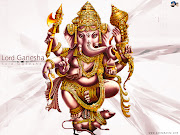| 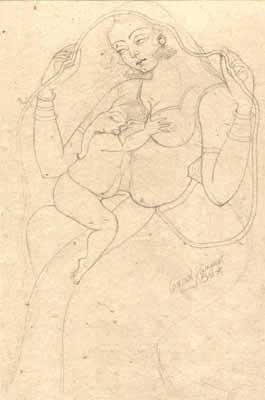 The beloved elephant-faced-Deity popularly known as Ganesha has intrigued thinking men all over the world, all through the ages even unto the present day. The sacred texts give a variety of stories narrating the sequence of Ganesha's birth. The most popular being the one mentioning that Ganesha was created by Goddess Parvati as a guardian to her privacy: The beloved elephant-faced-Deity popularly known as Ganesha has intrigued thinking men all over the world, all through the ages even unto the present day. The sacred texts give a variety of stories narrating the sequence of Ganesha's birth. The most popular being the one mentioning that Ganesha was created by Goddess Parvati as a guardian to her privacy:
Incensed by the refusal of her husband to respect her privacy, to the extent of entering her private chambers even while she was having her bath, Parvati decided to settle matters once and for all. Before going for her bath the next time, she rubbed off the sandalwood paste on her body and out of it created the figure of a young boy. She infused life into the figure and told him he was her son and should guard the entrance while she bathed. 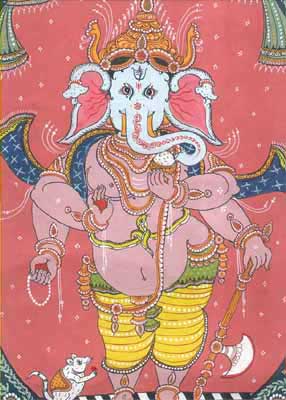 Soon after, Shiva (Lord of destruction and husband of Parvati,) came to see Parvati but the young boy blocked his way and would not let him in. Shiva, unaware that this lad was his son, became furious and in great anger fought with this boy whose head got severed from his body in the ensuing battle. Parvati, returning from her bath, saw her headless son and threatened in her rage to destroy the heavens and the earth, so great was her sorrow. Soon after, Shiva (Lord of destruction and husband of Parvati,) came to see Parvati but the young boy blocked his way and would not let him in. Shiva, unaware that this lad was his son, became furious and in great anger fought with this boy whose head got severed from his body in the ensuing battle. Parvati, returning from her bath, saw her headless son and threatened in her rage to destroy the heavens and the earth, so great was her sorrow.
Shiva pacified her and instructed his followers (known as ganas) to bring the head of the first living being they encounter. The first creature they encountered was an elephant. They thus cut off its head and placed it on the body of Parvati's son and breathed life into him. Thus overjoyed, Parvati embraced her son. 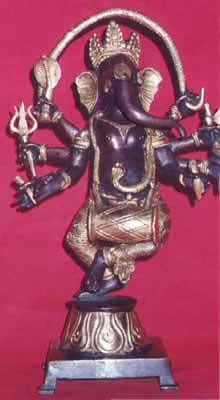
The son of Parvati was given the name Ganesha by Shiva. The word Ganesha is made up of gana (followers of Shiva) and isha (lord), thus Shiva appointed him the lord of his ganas. Ganesha is usually depicted either as a pictograph or as an idol with the body of a man and the head of an elephant, having only one tusk, the other tusk appearing broken. His unique feature, besides the elephant head, is the large belly practically falling over his lower garment. On his chest, across his left shoulder, is his sacred thread, often in the form of a snake. The vehicle of Ganesha is the mouse, often seen paying obeisance to his lord. 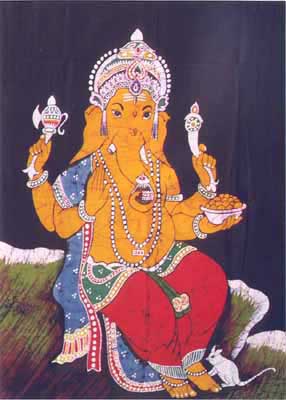
According to the strict rules of Hindu iconography, Ganesha figures with only two hands are taboo. Hence, Ganesha figures are most commonly seen with four hands which signify their divinity. Some figures may be seen with six, some with eight, some with ten, some with twelve and some with fourteen hands, each hand carrying a symbol which differs from the symbols in other hands, there being about fifty seven symbols in all, according to the findings of research scholars. 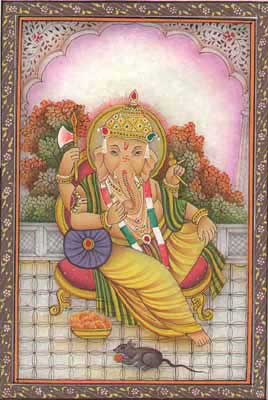
The physical attributes of Ganesha are themselves rich in symbolism. He is normally shown with one hand in the abhaya pose of protection and refuge and the second holding a sweet (modaka) symbolic of the sweetness of the realized inner self. In the two hands behind him he often holds an ankusha (elephant goad) and a pasha (noose). The noose is to convey that worldly attachments and desires are a noose. The goad is to prod man to the path of righteousness and truth. With this goad Ganesha can both strike and repel obstacles. 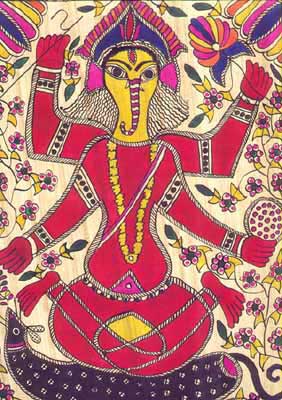
His pot belly signifies the bounty of nature and also that Ganesha swallows the sorrows of the Universe and protects the world. The image of Ganesha is a composite one. Four animals viz., man, elephant, the serpent and the mouse have contributed for the makeup of his figure. All of them individually and collectively have deep symbolic significance. The image of Ganesha thus represents man's eternal striving towards integration with nature. He has to be interpreted taking into consideration the fact that though millenniums rolled by, man yet remains closer to animal today than he was ever before. The most striking feature of Ganesha is his elephant head, symbolic of auspiciousness, strength and intellectual prowess. All the qualities of the elephant are contained in the form of Ganpati. The elephant is the largest and strongest of animals of the forest. Yet he is gentle and, amazingly, a vegetarian, so that he does not kill to eat. He is very affectionate and loyal to his keeper and is greatly swayed if love and kindness are extended to him. Ganesha, though a powerful deity, is similarly loving and forgiving and moved by the affection of his devotees. But at the same time the elephant can destroy a whole forest and is a one-man army when provoked. Ganesha is similarly most powerful and can be ruthless when containing evil. 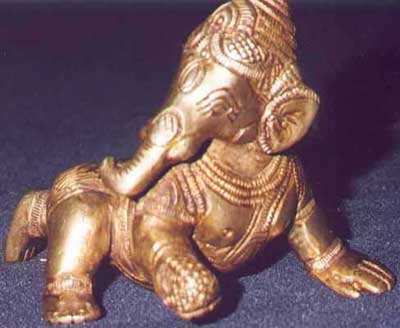 Again, Ganesha's large head is symbolic of the wisdom of the elephant. His large ears, like the winnow, sift the bad from the good. Although they hear everything, they retain only that which is good; they are attentive to all requests made by the devotees, be they humble or powerful. Again, Ganesha's large head is symbolic of the wisdom of the elephant. His large ears, like the winnow, sift the bad from the good. Although they hear everything, they retain only that which is good; they are attentive to all requests made by the devotees, be they humble or powerful. Ganesha's trunk is a symbol of his discrimination (viveka), a most important quality necessary for spiritual progress. The elephant uses its trunk to push down a massive tree, carry huge logs to the river and for other heavy tasks. The same huge trunk is used to pick up a few blades of grass, to break a small coconut, remove the hard nut and eat the soft kernel inside. The biggest and minutest of tasks are within the range of this trunk which is symbolic of Ganesha's intellect and hiss powers of discrimination. An intriguing aspect of Ganesha's iconography is his broken tusk, leading to the appellation Ekdanta, Ek meaning one and danta meaning teeth. It carries an interesting legend behind it: When Parashurama one of Shiva's favorite disciples, came to visit him, he found Ganesha guarding Shiva's inner apartments. His father being asleep, Ganesha opposed Parshurama's entry. Parashurama nevertheless tried to urge his way, and the parties came to blows. Ganesha had at first the advantage, seizing Parashurama in his trunk, and giving him a twirl that left him sick and senseless; on recovering, Rama threw his axe at Ganesha, who recognizing it as his father's weapon (Shiva having given it to Parashurama) received it with all humility upon one of his tusks, which it immediately severed, and hence Ganesha has but one tusk.  A different legend narrates that Ganesha was asked to scribe down the epic of Mahabharata, dictated to him by its author, sage Vyasa. Taking into note the enormity and significance of the task, Ganesha realized the inadequacy of any ordinary 'pen' to undertake the task. He thus broke one of his own tusks and made a pen out of it. The lesson offered here is that no sacrifice is big enough in the pursuit of knowledge. A different legend narrates that Ganesha was asked to scribe down the epic of Mahabharata, dictated to him by its author, sage Vyasa. Taking into note the enormity and significance of the task, Ganesha realized the inadequacy of any ordinary 'pen' to undertake the task. He thus broke one of his own tusks and made a pen out of it. The lesson offered here is that no sacrifice is big enough in the pursuit of knowledge.
An ancient Sanskrit drama titled "Shishupalvadha", presents a different version. Here it is mentioned that Ganesha was deprived of his tusk by the arrogant Ravana (the villain of Ramayana), who removed it forcefully in order to make ivory earrings for the beauties of Lanka! The little mouse whom Ganesha is supposed to ride upon is another enigmatic feature in his iconography. At a first glance it seems strange that the lord of wisdom has been granted a humble obsequious mouse quite incapable of lifting the bulging belly and massive head that he possesses. But it implies that wisdom is an attribute of ugly conglomeration of factors and further that the wise do not find anything in the world disproportionate or ugly. 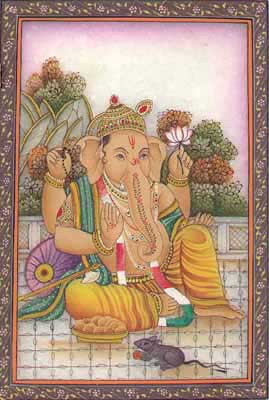 The mouse is, in every respect, comparable to the intellect. It is able to slip unobserved or without our knowledge into places which we would have not thought it possible to penetrate. In doing this it is hardly concerned whether it is seeking virtue or vice. The mouse thus represents our wandering, wayward mind, lured to undesirable or corrupting grounds. By showing the mouse paying subservience to Lord Ganesha it is implied that the intellect has been tamed through Ganesha's power of discrimination. The mouse is, in every respect, comparable to the intellect. It is able to slip unobserved or without our knowledge into places which we would have not thought it possible to penetrate. In doing this it is hardly concerned whether it is seeking virtue or vice. The mouse thus represents our wandering, wayward mind, lured to undesirable or corrupting grounds. By showing the mouse paying subservience to Lord Ganesha it is implied that the intellect has been tamed through Ganesha's power of discrimination.
Any attempt to penetrate the depths of the Ganesha phenomenon must note that he is born from Goddess Parvati alone without the intervention of her husband Shiva, and as such he shares a very unique and special relationship with his mother. The sensitive nature of his relationship with Parvati is made amply clear in the following tale: As a child, Ganesha teased a cat by pulling its tail, rolling it over on the ground and causing it great pain, as naughty young boys are wont to do. After some time, tired of his game, he went to his mother Parvati. He found her in great pain and covered with scratches and dust all over. When he questioned her, she put the blame on him. She explained that she was the cat whom Ganesha had teased. His total devotion towards his mother is the reason why in the South Indian tradition Ganesha is represented as single and celibate. It is said that he felt that his mother, Parvati, was the most beautiful and perfect woman in the universe. Bring me a woman as beautiful as she is and I shall marry her, he said. None could find an equal to the beautiful Uma (Parvati), and so the legend goes, the search is still on... 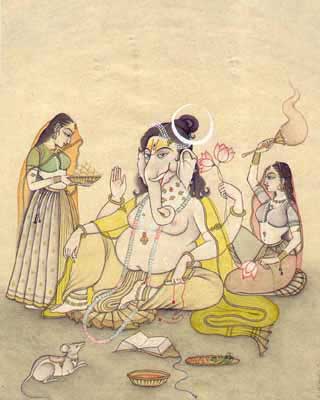 In variance with the South Indian tradition, in North India Ganesha is often shown married to the two daughters of Brahma (the Lord of Creation), namely Buddhi and Siddhi. Metaphorically Buddhi signifies wisdom and Siddhi achievement. In the sense of yoga, Buddhi and Siddhi represent the female and male currents in the human body. In visual arts this aspect of Ganesha is represented with grace and charm. 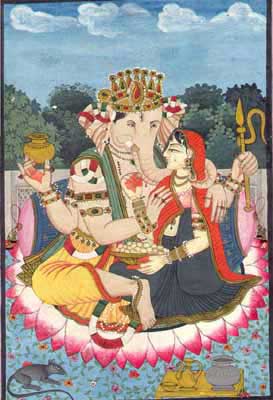
In a different, slightly erotic version from Tantric thought, Ganesha is depicted in a form known as "Shakti Ganpati". Here he is depicted with four arms, two of them holding symbolic implements. With the other two arms he fondles his consort, who is comfortably balanced on his left thigh. The third eye in this representation, is of course the eye of wisdom, which sees above and beyond mere physical reality. No analysis of Lord Ganesha can be concluded without a mention of the mystical syllable AUM. The sacred AUM is the most powerful Universal symbol of the divine presence in Hindu thought. It is further said to be the sound which was generated when the world first came into being. The written manifestation of this divine symbol when inverted gives the perfect profile of the god with the elephant head.  Ganesha is thus the ONLY god to be associated in a "physical" sense with the primordial sacred sound AUM, a telling reminder of his supreme position in the Hindu pantheon. | 




















 There are 250 temples of Ganesha in Japan.
There are 250 temples of Ganesha in Japan. 







 Showalter for News
Showalter for News














